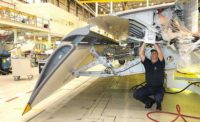Today’s assembly plants are undergoing a major evolution, as Industry 4.0 technology is rapidly being adopted across many industries. This technology will form the foundation for a next-generation vision of manufacturing: the factory of the future. This new factory is an intelligent, flexible and highly agile production environment that equips plant operations and management personnel with real-time, in-depth information to maximize the value and performance of every machine and production unit.
Although the factory of the future may sound like a lofty concept, the groundwork for implementing this vision has actually been in place for some time. One crucial foundation in the journey toward the factory of the future is the concept of lean manufacturing. Developed decades ago as a method to improve productivity, lean manufacturing emphasizes eliminating waste, implementing continuous improvement and improving the flow of material, people and information—both within individual production lines and across manufacturing enterprises.
Similarly, Industry 4.0 technology is being engineered to achieve essentially parallel goals: improving communications, capturing real-time and historic manufacturing data in an automated fashion, and applying intelligent technology to improve productivity, throughput and quality while reducing wasted time, energy and resources.
Manufacturers and plant operators have begun to appreciate the impact that Industry 4.0 technology offers their businesses. However, the best way to maximize the potential this technology offers is by also applying lean principles and thinking to the ways they address waste and errors in their operations. Otherwise, they risk wasting time and resources on technology that will not help them realize their own factory of the future.
Value and Impact of Lean
Lean manufacturing has proven to be a powerful set of principles and processes for helping manufacturers become more productive, agile and able to deliver the highest quality goods while controlling costs and staying competitive. Lean manufacturing provides a systematic way to identify and eliminate waste. At its most elemental level, lean manufacturing is “pull” production, driven by customer or marketplace demand. Lean production optimizes all of an enterprise’s flow in response to that demand: material flow, people flow and information flow.
Organizations that are successful at applying lean have invested time and resources in understanding how materials and information flow through their manufacturing processes. The goal is to eliminate the seven types of waste in manufacturing: overproduction, waiting, defects and errors, excess motion and movement, excess inventory, inefficient processes, and excess transportation.
Lean Meets Factory of the Future
It takes information to root out the sources of waste. In the factory of the future, Industry 4.0 technology significantly increases and enriches the density of information about manufacturing systems. In the factory of the future, everything can be connected, from the individual machine components with embedded sensors and intelligence up through machine-level and plant-level communications architectures to cloud-based systems.
Sophisticated software collects, transfers and processes data in ways that provide both production transparency and actionable answers to questions about production bottlenecks, inefficient workflows and equipment in need of preventive maintenance.
Industry 4.0 technology like this is making it possible for manufacturers to access vital information about their workflows in a more usable, real-time, trackable fashion. For example, real-time data on the condition of motors or bearings can be acted on much faster to prevent unscheduled downtime or damage to machines.
Along with real-time, actionable data, historical and trending data from a much wider range of inputs can be gathered and analyzed. This data can be gathered automatically and compiled according to lean principles to gain a deeper and more cohesive picture of the performance of production systems. This can help identify areas where continuous improvement processes need to be implemented.
Freeing Personnel to Add Value
Another key benefit this technology offers is the ability to free up people who are normally tasked with monitoring and compiling lean-related data and reporting it throughout the plant. In many plants with mature lean practices, personnel must complete reports and post them to andon boards so that production teams can review data and make production decisions.
Now, advanced communications systems can automate much of this work, much more accurately and faster. These interactive communications platforms process and visualize production data in real time, and they can network with IT applications, such as production planning, quality data management and e-mail, to provide information as the basis for decisions and process improvements.
With these tools, it can be possible to free data-gatherers and report-makers to complete other jobs, such as implementing the actual continuous improvement processes. In short, workers can actually improve efficiency rather than just report what’s happening.
Lean and Industry 4.0
One of the major challenges many companies face in the journey toward the factory of the future is intelligently managing the mountains of data that Industry 4.0 systems can offer. Companies that seek to incorporate intelligence into their production systems often discover that they have no way of knowing what functions or process points they need to measure in the first place to make full use of their technology investment.
It is vital for organizations taking the next step toward the factory of the future to have well-established and effective lean principles in place before they invest in Industry 4.0 technology. Unless they understand how lean drives improvements in their business and operations, they run the risk that bad data will multiply the cost of their technology investment while making no measurable improvement in performance or return on the investment.
It can be very easy (but detrimental) for organizations to invest a significant amount of money in Industry 4.0 technology before they realize that they should have first assessed how lean they are. But, an honest self-assessment will ensure that their foundation is solid before they make any significant investments.
For example, if a plant is monitoring output or downtime on an assembly line, and it’s discovered that the line is down for 20 to 25 minutes per week, simply adding sensors or upgrading the controls platform will not necessarily indicate the source of the persistent downtime. Instead, engineers should take a step back and consider what data will help them improve an operation. Only then can they strategically deploy the right sensors, to collect the right data, and get it to the right individuals to analyze and act on.
One new technology that can help accomplish this improved information flow is called an Industry 4.0 gateway or IoT (Internet of Things) gateway. These tools are designed to aggregate a host of sensor and machine data and provide intelligent ways to present that data for higher-level analysis. These gateways can be stand-alone systems or integrated into PLC platforms. They can capture data from PLCs, machine drives and sensors monitoring a range of machine and manufacturing conditions.
Through these gateways, plant management can identify problem areas that normal human observation might not capture—everything from room temperature, humidity, noise and vibration levels and other inputs. This data can be presented to higher-level analytical systems in ways that they can be more efficiently studied. These gateways are sophisticated enough to enable product performance management or quality management software to use machine-learning tools to compare similar applications across a plant environment. They can even access cloud computing to compare performance factors across different plants in different global locations.
These tools could easily set manufacturers up to be smothered by a mountain of data. However, by being disciplined in the use of lean processes, it is possible to make sure these systems are capturing the right data and helping engineers find the root causes of downtime and other sources of waste or poor quality.
Technology Enhances Manual Production
Lean manufacturing has significantly transformed manual assembly. Now, lean principles and factory of the future technology are combining to make manual and hybrid (combined manual and automated) workcells reach new levels of efficiency and flexibility. Flexible conveyor systems equipped with bar code readers or RFID scanners can efficiently deliver a steady flow of materials to workstations just as they are needed. Intelligent staging ensures that the workpiece is always oriented in the best position for maximum ergonomic efficiency.
Smart workstations that incorporate interactive digital assembly guides and vision systems can further reduce errors. Worker-assist systems can be programmed to present information in the worker’s language of choice and automatically reconfigure to match the part being assembled.
Programmable tightening tools can automatically reconfigure torque and rotation settings based on the device being assembled. These tools can also document that each fastener has been installed, that fasteners were installed in the correct sequence, and that the right amount of torque and angle was applied to each bolt. These tools can reduce the amount of training or supervisor support needed for new personnel. Newer systems are smart enough to assist and track each step of the assembly process. They can even notify workers when they are about to make an error.
Smart assembly assist systems can ensure that the right part is pulled from the right bin, preventing errors and reducing wasted motion. And, since these systems are tracking and reporting each workcell’s assembly time, they provide a powerful tool to help address takt time and what steps could be taken to reduce the time spent waiting.
Digitizing Lean
Industry 4.0 technology being introduced to create the factory of the future can help facilitate some of the fundamental concepts of lean: reducing waste and improving the flow of material, people and information—especially information.
However, it’s important to recognize that technology alone cannot implement lean. In many ways, unless a plant is fully invested in lean principles and processes, any investment in new technology could be wasted. There are three elements that companies must have in place to make the best use of Industry 4.0 technology:
- A commitment to applying lean principles to identify waste and its root causes.
- Real continuous improvement processes that provide clear feedback mechanisms across the enterprise, so that inputs from all personnel—line managers, production workers and maintenance staff—are captured and evaluated continuously.
- An agile methodology for implementing improvements.
With the advent of factory of the future systems, agility becomes even more critical: The real-time and historical trending data that Industry 4.0 systems can provide will supply actionable data to answer questions about how to improve productivity, reduce waste and become more responsive to changing market conditions.
By applying lean principles to help understand and improve the assembly process, engineers can make the right technology investments to intelligently move forward on the journey to the factory of the future.








